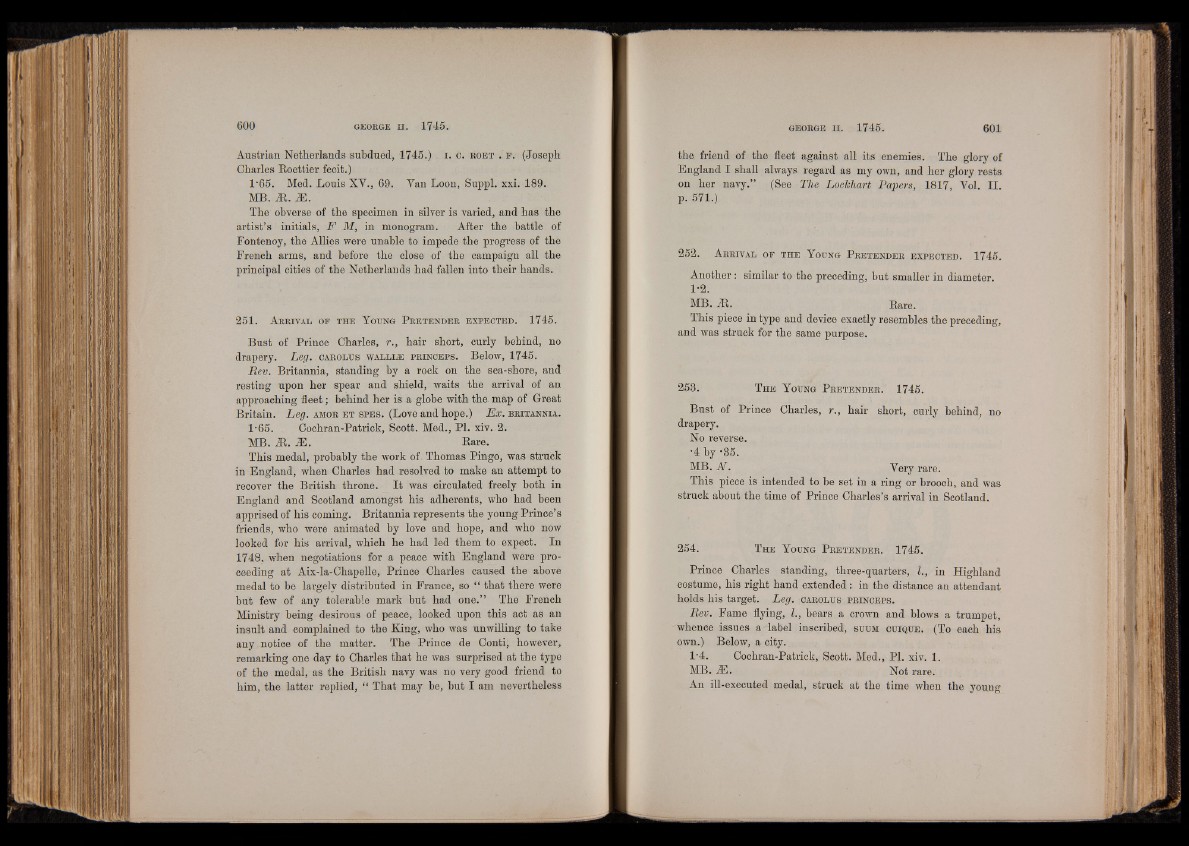
Austrian Netherlands subdued, 1745.) . i. c. r o e t . f . (Joseph
Charles Roettier fecit.)
l -65. Med. Louis XV., 69. Van Loon, Suppl. xxi. 189.
MB. At. Ah
The obverse of the specimen in silver is varied, and has the
artist’s initials, F M, in monogram. After the battle of
Fontenoy, the Allies were unable to impede the progress of the
French arms, and before the close of the campaign all the
principal cities of the Netherlands had fallen into their hands.
251. A r r iv a l o f t h e Y oung P r e t e n d e r e x p e c t e d . 1745.
Bust of Prince Charles, r., hair short, curly behind, no
drapery. Leg. c a ro lu s w a l l l e p r in c e p s . Below, 1745.
Rev. Britannia, standing by a rock on the sea-shore, and
resting upon her spear and shield, waits the arrival of an
approaching fleet; behind her is a globe with the map of Great
Britain. Leg. amor e t s p e s . (Love and hope.) Ex. Br it a n n ia .
1-65. Cochran-Patrick, Scott. Med., PI. xiv. 2.
MB. At. AS. Rare.
This medal, probably the work of Thomas Pingo, was struck
in England, when Charles had resolved to make an attempt to
recover the British throne. It was circulated freely both in
England and Scotland amongst his adherents, who had been
apprised of his coming. Britannia represents the young Prince’s
friends, who were animated by love and hope, and who now
looked for his arrival, which he had led them to expect. In
1748. when negotiations for a peace with England were proceeding
at Aix-la-Chapelle, Prince Charles caused the above
medal to be largelv distributed in France, so “ that there were
but few of any tolerable mark but had one.” The French
Ministry being desirous of peace, looked upon this act as an
insult and complained to the King, who was unwilling to take
any notice of the matter. The Prince de Conti, however,
remarking one day to Charles that he was surprised at the type
of the medal, as the British navy was no very good friend to
him, the latter replied, “ That may be, but I am nevertheless
the friend of the fleet against all its enemies. The glory of
England I shall always regard as my own, and her glory rests
on her navy.” (See The Lockhart Papers, 1817, Vol. II.
p. 571.)
252. A r r iv a l o f t h e Y o u n g P r e t e n d e r e x p e c t e d . 1745.
Another: similar to the preceding, but smaller in diameter.
1-2.
MB. At. Rare.
This piece in type and device exactly resembles the preceding,
and was struck for the same purpose.
258. T h e Y o u n g P r e t e n d e r . 1745.
Bust of Prince Charles, r., hair short, curly behind, no
drapery.
No reverse.
•4 by -35.
MB. AT. Very rare.
This piece is intended to be set in a ring or brooch, and was
struck about the time of Prince Charles’s arrival in Scotland.
254. T h e Y o u n g P r e t e n d e r . 1745.
Prince Charles standing, three-quarters, I., in Highland
costume, his right hand extended: in the distance an attendant
holds his target. Leg. carolus . p r in c e p s .
Rev. Fame flying, I., bears a crown and blows a trumpet,
whence issues a label inscribed, su um c u iq u e . ( T o each his
own.) Below, a city.
1‘4. Cochran-Patrick, Scott. Med., PI. xiv. 1.
MB. A3. Not rare.
An ill-executed medal, struck at the time when the young